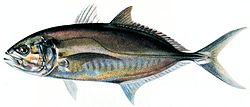Gnathostomata
| Jawed vertebrates | |
|---|---|

| |
| Example of jawed vertebrates: Tetrapoda ).
| |
| Scientific classification | |
| Domain: | Eukaryota |
| Kingdom: | Animalia |
| Phylum: | Chordata |
| Clade: | Olfactores |
| Subphylum: | Vertebrata |
| Infraphylum: | Gnathostomata Gegenbauer, 1874 |
| Subgroups | |
| |
Gnathostomata (
It is now assumed that Gnathostomata evolved from ancestors that already possessed two pairs of
Jaw development in vertebrates is likely a product of bending the first pair of
Newer research suggests that a branch of placoderms was most likely the ancestor of present-day gnathostomes. A 419-million-year-old fossil of a placoderm named Entelognathus had a bony oral skeleton and anatomical details associated with cartilaginous and bony fish, demonstrating that the absence of a bony skeleton in cartilaginous fish is a derived trait.[12] The fossil findings of primitive bony fishes such as Guiyu oneiros and Psarolepis, which lived contemporaneously with Entelognathus and had pelvic girdles more in common with placoderms than with other bony fish, show that it was a relative rather than a direct ancestor of the extant gnathostomes.[13] It also indicates that spiny sharks and Chondrichthyes represent a single sister group to the bony fishes.[12] Fossil findings of juvenile placoderms, which had true teeth that grew on the surface of the jawbone and had no roots, making them impossible to replace or regrow as they broke or wore down as they grew older, proves the common ancestor of all gnathostomes had teeth and place the origin of teeth along with, or soon after, the evolution of jaws.[14][15]
Late
Classification
Gnathostomata is traditionally an
Vertebrata : Gnathostomata
|
| ||||||||||||||||||||||||||||||
| Subgroups of jawed vertebrates | ||||
|---|---|---|---|---|
| Subgroup | Common name | Example | Comments | |
Placodermi (extinct) |
Armoured fish | 
|
† Late Devonian extinctions , and the class was entirely extinct by the end of the Devonian.
| |
| Chondrichthyes | Cartilaginous fishes | 
|
rays and skates) and Holocephali (chimaeras, sometimes called ghost sharks, which are sometimes separated into their own class). Within the infraphylum Gnathostomata, cartilaginous fishes are distinct from all other jawed vertebrates, the extant members of which all fall into Teleostomi .
| |
| † Acanthodii (extinct) |
Spiny sharks | 
|
† Fanjingshania is the tooth-based acanthodian species Qianodus duplicis[20] that represents the oldest unequivocal toothed vertebrate.
| |
| Osteichthyes | Bony fishes | 
|
Osteichthyes (bone-fish) or bony fishes are a taxonomic group of fish that have bone, as opposed to cartilaginous skeletons. The vast majority of fish are osteichthyans, which is an extremely diverse and abundant group consisting of 45 orders, with over 435 families and 28,000 species.[21] It is the largest class of vertebrates in existence today. Osteichthyes is divided into the ray-finned fish (Actinopterygii) and lobe-finned fish (Sarcopterygii). The oldest known fossils of bony fish are about 420 million years ago, which are also transitional fossils, showing a tooth pattern that is in between the tooth rows of sharks and bony fishes.[22] | |
Tetrapoda
|
Tetrapods | 
|
palaeontologists at present.
| |
Evolution
The appearance of the early vertebrate jaw has been described as "a crucial innovation"
The ancestor of all jawed vertebrates have gone through two rounds of whole genome duplication. The first happened before the gnathostome and cyclostome split, and appears to have been an autopolyploidy event (happened within the same species). The second occurred after the split, and was an allopolyploidy event (the result of hybridization between two lineages).[30]
The customary view is that jaws are
While potentially older
References
- ^ PMID 25903631.
- PMC 3866411.
- ^ ISBN 978-1-4987-0756-5. Retrieved 14 September 2016.
- S2CID 233943453
- S2CID 226284286.
- PMID 16497590.
- ^ PMID 22219394– via Research Gate.
- ^ "The first vertebrate sexual organs evolved as an extra pair of legs". Archived from the original on 20 December 2016. Retrieved 4 July 2014.
- S2CID 32317622. Archived from the original(PDF) on 18 October 2016. Retrieved 15 September 2016.
- PMID 25520359.
- ^ Gridi-Papp, Marcos (2018). "Comparative Oral+ENT Biology" (2018). Pacific Open Texts. 4. Pacific Open Texts.
- ^ S2CID 4462506.
- PMID 22509388.
- ^ Choi, Charles Q. (17 October 2012). "Evolution's Bite: Ancient Armored Fish Was Toothy, Too". Live Science.
- S2CID 4302415.
- ^ Hanke, Gavin; Wilson, Mark (January 2004). "New teleostome fishes and acanthodian systematics". Journal of Vertebrate Paleontology: 187–214 – via Research Gate.
- S2CID 4257631.
- ^ "Fossil reveals oldest live birth". BBC. 28 May 2008. Retrieved 30 May 2008.
- ^ S2CID 252570103.
- S2CID 252569771.
- ^ Bony fishes Archived 6 June 2013 at the Wayback Machine SeaWorld. Retrieved 2 February 2013.
- ^ Jaws, Teeth of Earliest Bony Fish Discovered
- ISBN 9780253356758.
- ISBN 9781405144490.
- PMID 11523812.
- .
- ISBN 978-0-8133-3807-1.
- ISBN 978-0-253-34926-2.
- S2CID 56425436.
- ^ Hagfish genome illuminates vertebrate whole genome duplications and their evolutionary consequences
- ^ For example: (1) both sets of bones are made from neural crest cells (rather than mesodermal tissue like most other bones); (2) both structures form the upper and lower bars that bend forward and are hinged in the middle; and (3) the musculature of the jaw seem homologous to the gill arches of jawless fishes. (Gilbert 2000)
- ^ Gilbert (2000). Evolutionary Embryology. Sinauer Associates.
- S2CID 33913758.
- S2CID 252570103.
- S2CID 252569771.
